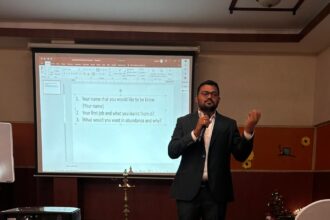[ad_1]
Later this month, delegations from around the world will head to a conference in Dubai to discuss international treaties involving radio frequencies, satellite coordination and other tricky technical issues. These include the nagging problem of the clocks.
For 50 years, the international community has carefully and precariously balanced two different ways of keeping time. One method, based on Earth’s rotation, is as old as human timekeeping itself, an ancient and common-sense reliance on the position of the sun and stars. The other, more precise method coaxes a steady, reliable frequency from the changing state of cesium atoms and provides essential regularity for the digital devices that dominate our lives.
The trouble is that the times on these clocks diverge. The astronomical time, called Universal Time, or UT1, has tended to fall a few clicks behind the atomic one, called International Atomic Time, or TAI. So every few years since 1972, the two times have been synced by the insertion of leap seconds — pausing the atomic clocks briefly to let the astronomic one catch up. This creates UTC, Coordinated Universal Time.
But it’s hard to forecast precisely when the leap second will be required, and this has created an intensifying headache for technology companies, countries and the world’s timekeepers.
“Having to deal with leap seconds drives me crazy,” said Judah Levine, head of the Network Synchronization Project in the Time and Frequency Division at the National Institute of Standards and Technology, or NIST, in Boulder, Colo., where he is a leading thinker on coordinating the world’s clocks. He is constantly badgered for updates and better solutions, he said: “I get a bazillion emails.”
On the eve of the next international discussion, Dr. Levine has written a paper that proposes a new solution: the leap minute. The idea is to sync the clocks less frequently, perhaps every half-century, essentially letting atomic time diverge from cosmos-based time for 60 seconds or even a tad longer, and basically forgetting about it in the meantime.
“We all need to relax a little bit,” Dr. Levine said.
One World, Two Clocks
The troubles date to the early 1970s, with the introduction of atomic time. Until then, the world had largely relied on astronomical time. It seemed logical — the sun came up and there was day, then it went down and there was night and so forth, although there were minor irregularities caused by the slowing of Earth’s rotation and other natural forces. These variations went largely unnoticed by humans. Not so much by machines.
Computers require precise, lock-step timekeeping so that their commands stay orderly. After atomic time’s introduction, it became essential to a growing number of functions — like landing airplanes and timing stock trades — not without a growing number of problems as society got more mechanized.
“Cesium clocks became very common, and right away there was a problem,” Dr. Levine said. “The astronomical clock and the cesium clock began to walk away from each other.”
The introduction of the leap second in 1972 codified that a second would be introduced each time the two clocks diverged by more than 0.9 seconds. This had at least three aims: to keep time connected to the natural world and the tradition of astronomy; to suit digital technology; and to reconcile and synchronize the two clocks. Over the last 50 years, leap seconds have been used 27 times.
Around the turn of this century, another problem arose, driven by a new set of stakeholders: big technology companies. The likes of Google, Amazon and Facebook developed their own methods for reconciling astronomical and atomic time, essentially bypassing the leap second. Meta, for instance, “smears” the leap second in millisecond increments across a 17-hour period, rather than leaping abruptly. But there are many methods, creating a timekeeping free-for-all and threatening uniformity.
“We made a mess of time all over the world,” said Patrizia Tavella, director of the Time Department at the International Bureau of Weights and Measures in Paris.
Dr. Levine, with his leap-minute solution, is highly regarded among time-keeping scientists, said Demetrios Matsakis, a former director of the U.S. Naval Observatory’s Time Service Department. (In 2009, Dr. Levine won the prestigious Time Lord award, given by the International Timing and Sync Forum).
For this and other reasons, Dr. Matsakis finds the new proposal compelling. “If they’re coming in strongly for one minute, that would be a new emphasis,” he said. It’s “the kind of thing that could be politically solvable,” he added. “It just may be the winner.”
Then again, he said, the proposal could stall like previous proposals aimed at reconciling the clocks, ground to a halt by an international community of vested interests and strong opinions.
“You’re dealing largely with hysteria,” Dr. Matsakis said.
The Vatican and the Russians
At one point in the last year, Dr. Tavella spoke to the Rev. Paul Gabor, an astrophysicist and the vice director of the Vatican Observatory Research Group in Tucson, Ariz., about the leap second. His concern, she said, was that “eliminating the idea could create some uneasiness, as humans feel connected and want to remain connected to the natural world.” Also: “Men look to the sky and count days; this is something ‘unspoken’ but deep in the heart of men.”
Other timekeepers and diplomats felt that losing the leap second would disconnect official time from the ancient traditions of astronomy and eventually lead to the pre-eminence of the accurate but lab-created atomic clocks. Among the fiercest opponents over the years has been the British government, which controlled Greenwich Mean Time (what is now Coordinated Universal Time), an astronomical clock that is determined by averaging the position of the sun over the year.
Dr. Levine said he sympathized. “The public has this great distrust of scientists as people who propose something that seems to go against common sense,” he said.
And yet, he said, the persistence of Daylight Saving Time appears to be an admission that people are comfortable “with changing the connection between time and everyday astronomy.”
Over the last decade, the growing challenges of implementing the leap second have prompted a willingness to change the current system. A sea change occurred last November when the member states of the International Bureau of Weights and Measures declared it was ready to explore alternatives to the leap second. No proposal was adopted, but the ground was laid for considering options, like scrapping the leap second or relaxing the relationship between astronomical and atomic time.
There were holdouts, notably the Russians, who have argued vigorously if mysteriously for keeping the leap second. The presumption is that the Russian Glonass satellite system is built to account for leap seconds and that altering the current timekeeping methodology could have military implications.
“Nobody fully understands this,” said Elizabeth Donley, chief of the Time and Frequency Division of NIST. “It’s probably a matter of national security. They never really give a good answer.”
Which brings the world community to the World Radio Conference, the meeting to be held starting Nov. 20 in Dubai. The agenda calls for discussions about the leap second, but American time scientists are not optimistic that the conversation will yield a result. Any proposed change would require consensus among all the attending nations, including Russia.
Dr. Matsakis is more hopeful that a new method may be codified in the next two years at other conferences that don’t require full consensus. For now, the leap minute proposal has just begun to circulate as part of a draft paper that has not yet received the full scrutiny it will have to withstand. Its formal publication may well come after Dubai, although word of it will have spread.
For Dr. Levine, a decision can’t come soon enough; he is tired of dealing with the leap second and feels that his own time is waning. “It’s now or never,” he said. “I’m 84.” He paused: “Actually I’m 83, but my wife is 84 and I tend to think of us as the same age.”
U.S.T.: Universal Spouse Time.
Regardless, he said, “I’m not going to be around forever.”







